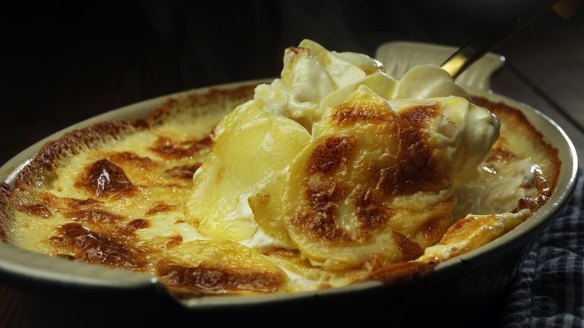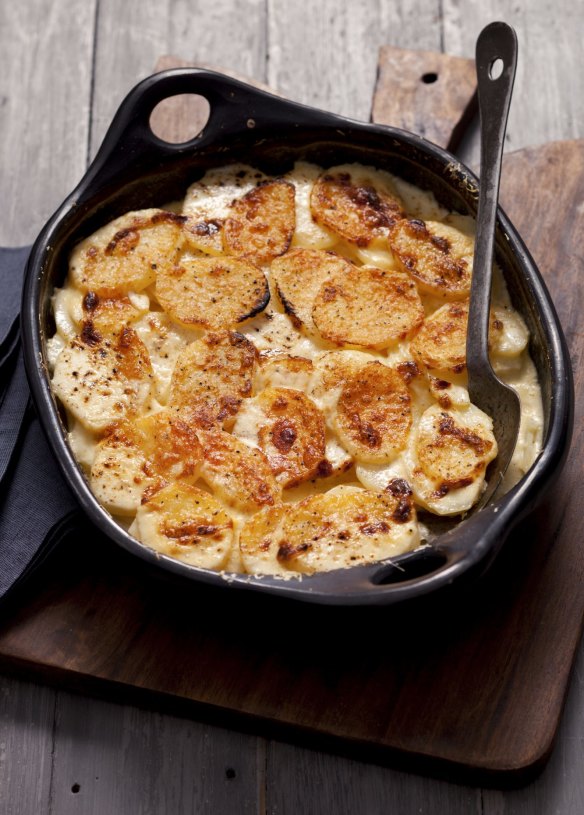How to make perfect pommes dauphinoise aka dreamy creamy potato gratin

Here are some things about dauphinoise potatoes (aka gratin or scalloped potatoes) and food in general: First, you've probably noticed that, whether it's our dreamy potato side dish or chocolate chip cookies or a steaming rack of Spam, the internet's fairly rotten with recipes. Nine bajillion and three, to be exact.
You've also noticed the multitudes of hyperbolic scriveners promising breathlessly "the best" recipe, "the best" restaurant, "the best" whatever. I hate to break it to you, kids, but there is no best. Ever. And that's because of The One Absolute Truth in the Universe. You remember: There's no accounting for taste.

In other words, I can help you make a perfectly palatable dauphinoise potatoes, but, I can't predict how you'll like it, because, well, there's just no accounting for taste, is there?
Add to that the fact that anytime we go into the kitchen, the choice of ingredients, coupled with the method of preparation, can result in wildly different finished products.
Our best (sic) option, then, is simply to give you the method for putting together a dauphinoise and then letting you take it from there. The components are simple: thinly sliced potatoes baked in a liquid dairy product with a little garlic, and maybe some cheese. Let's take a gander.
Potatoes
The world of potatoes exists on a spectrum between what we call "waxy" and "starchy". Any potato will work, of course, because it's a potato. However, for dauphinoise, we like the starch because it thickens the sauce and inhibits curdling. Thus, the mighty russet, repository of starch galore, is the typical tattie of choice.
Speaking of starch, usually we submerge cut potatoes in water to prevent browning. Not here, though, because soaking also dissolves starch and as we said, with dauphinoise, starch is our pal.
Peel and slice about 900 grams of taters into 3mm thick rounds. If you've got a mandoline , use it. Unless you possess the knife skills of an assassin, it's easier, faster and it produces more consistent cuts.
Garlic
As much as I love garlic, it's easy to overdo. Thus, one clove, minced, is usually enough.
Dairy
Normally, it's cream. If that's too rich, cut the cream with milk or stock. You could also use plain milk or even skim milk.
Now, low-fat dairy products curdle during cooking more easily than high-fat dairy products. Whatever you're using, to inhibit curdling, bring it all to a boil before baking: Combine the dairy, sliced potatoes and garlic in a saute pan or skillet, season it and set it over medium high heat.
Cheese
A cheeseless dauphinoise never hurt anyone, but, I love gruyere. Cheddar, mozzarella or anything melty will work, too.
The method
Once its contents are all a-simmer, the skillet can go straight from the stovetop into the oven. If you're using cheese, scoop half your potatoes from the skillet into a greased baking dish. Sprinkle on half your cheese, cover with the remaining potatoes, then add the rest of the cheese and pour in the simmering dairy.
Bake the dauphinoise in a 350-degree oven for about 45 minutes to an hour, until the potatoes are tender and golden brown. If they're tender but still pale, crank the heat for another five to 10 minutes.
Finally, when the dauphinoise emerges triumphant from the oven, let it rest for 15 to 30 minutes before serving. Or, and this is what I like because I'm fancy you can refrigerate it so it sets up nice and stiff.
To serve, use a knife or scone cutter to render it into individual portions of aesthetically pleasing geometric shapes. Place the servings on a baking-paper-covered baking tray and flash them in a hot oven for five to 10 minutes, just to warm them through, and, voila, a beautiful side dish that's as French as Edith Piaf eating a snail.
Pommes dauphinoise
It's delicious right out of the oven, but if you have time to make it in advance, refrigerate it overnight after baking. The next day – or up to three days later – cut it into squares or rounds before reheating and it will hold its shape for an elegant presentation.
INGREDIENTS
2 cups cream or 1 cup each cream and milk
1 clove garlic, minced
1½ tsp salt, or to taste
½ tsp white pepper, or to taste
1 pinch nutmeg
900g potatoes, peeled (such as russet)
METHOD
1. Heat oven to 175C. Place dairy product, garlic, salt, white pepper and nutmeg in a heavy-bottomed, oven-proof saute pan or skillet. Bring to a simmer over medium-high heat.
2. While mixture comes to a simmer, slice the potatoes into 3mm thick rounds on a mandoline or with a very sharp knife. (Do not store them in water as that will wash away some of the starch.)
3. Stir the potatoes into the simmering liquid. The liquid should cover the potatoes by about 3mm. This will lower the temperature a bit. When the liquid returns to a simmer, about five minutes, taste for seasoning. It's now ready to go into the oven; leave it in the skillet or pour the entire contents into a greased baking tin.
4. Bake uncovered until potatoes are tender and brown on top (about 40 to 45 minutes). If the potatoes are tender but have no colour, increase the oven temperature to 220C and continue baking until browned on top (about five to 10 minutes).
5. Rest dauphinoise 15 to 30 minutes before serving or refrigerate for up to three days. To serve after refrigeration, cut potatoes into squares or rounds and place in a 250C oven until heated through (about five to 10 minutes).
Serves 8
James P. DeWan is a culinary instructor and the author of Prep School.
Chicago Tribune
Appears in these collections
The best recipes from Australia's leading chefs straight to your inbox.
Sign up- More:
- How to